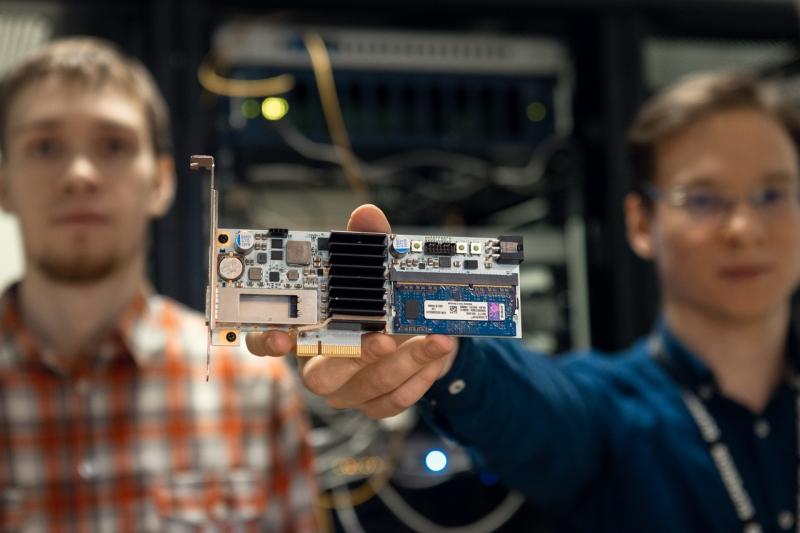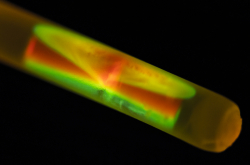A printed circuit board and 3D circuit assembly plant
Today, Alexander Kuznetsov is a young associate professor at the Faculty of Secure Information Technologies, but only a few years ago, he was a PhD student at work on his R&D project on engineering of electronic devices. As a result of his project, a special unit was created for manufacturing printed circuit boards accompanied by a special software package.
“Our installation was not only meant for normal printed circuit board production, but also for conductive 3D structures, where conductors are randomly placed, or, in other words, 3D circuit boards,” explains Alexander. “Such circuits are primarily used in portable electronic devices because they can assume any form we might need depending on our demands. We used rapid prototyping as a basic technology, and applied plastic and conductive filaments to form conductors in 3D circuits.”

Prototypes created with the installation can help precisely assess how a certain circuit will fit into its designated place within the electronic device. By working on the installation’s rigidity, guide screws, and vibration prevention, the developers have managed to ensure up to five micron detail shaping precision. The installation is also capable of creating a body for your future device using regular 3D printing.
Although the installation is yet to find its industrial application, it has already become an indispensable tool in student training.
“This project is used to teach Master’s students of the program in Design of Cyber-Physical Systems in Information Security,” continues Alexander. “As part of their course project, students have to create three electronic devices with the help of our installation. Such a task allows them to get a unique end-to-end design experience from a digital mockup to the production of the actual device. Moreover, we are now updating the hardware part of the installation, changing its electronic structure and trying out some new controllers. Our project keeps improving, which might lead us to enter the market in the future.”
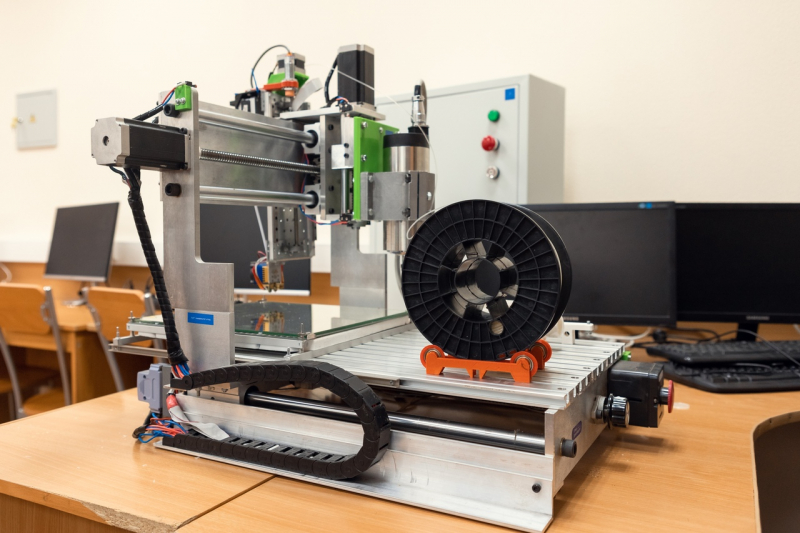
A smart network adapter to counter DDoS attacks
“A Hardware and Software Platform for Distributed Denial of Service Attack Resistance” – that’s the name of the recently completed project headed by Ilya Popov, a PhD student at ITMO’s Faculty of Secure Information Technologies. In other words, a team of engineers and programmers has created a network adapter with accompanying software to help protect servers from DDoS attacks on data transmission rates up to 40 Gbit/s.

“The ultimate aim of a DDoS attack is overflooding the computing resources of a server, as well as its network resources, with superfluous network packages,” clarifies Ilya. “A heavy flow of network packages is generated with the help of special programs and sent to a server that cannot process all of them. One of the possible outcomes of such an attack is that the website located on the targeted server might no longer be available, or, depending on the type of the attack, even the server itself might become inaccessible.”

These days, DDoS attacks can be conducted relatively easily with simple tools that don’t require a potential attacker to possess any particular qualification. Nevertheless, they can cause some serious trouble for any organization (e.g. a bank, a newspaper, or a university) that fell victim to this kind of wrongdoing. The current topical problem has to do with the fact that data transmission rates are getting higher, meaning that we need to be able to analyze traffic and detect attacks on the go. Malicious requests have to be separated from those coming from actual website users, who view pages, reload them, and follow links at no additional transmission speed costs. It is exactly what the smart network adapter together with software based on complex algorithms and machine learning was created to do.
“Malicious traffic sent by ill-wishers is more or less the same,” explains Ilya. “Regular users cannot possibly emulate this traffic even if they continually press F5. The page will always be refreshed at slightly different intervals. Moreover, users are unlikely to spend several uninterrupted hours refreshing a page.”
The next stage of the project will be implementing the device to protect ITMO’s own servers, followed by the platform entering the market. Right now, the system is at work protecting the server cluster of the Faculty of Secure Information Technologies.
“The solutions currently available on the market are more expensive than the system we offer. Moreover, our platform can operate at higher transmission rates than most of its competitors – one such device can handle an attack on up to 40 Gbit/s transmission rate,” continues Ilya. “With several of them we can filter traffic on up to 1 Tbit/s rate, surpassing a lot of available commercial solutions. The system is now being tested on the serves of our faculty. So far, we have disrupted 100% of attacks.”
A drone model testing stand
Sergey Chuprov’s R&D project also had to do with safety and security – he was preoccupied with ensuring a zero-accident rate for drones. Together with a team of researchers, he was able to create a stand for testing the algorithms currently controlling the movement of robots at smart storing facilities and production sites with a potential application in driverless cars.

The stand itself is a black and white checkered surface that looks like an enormous (3x3 meters) chess board with a set of wheeled pilotless robots that can navigate the surface and exchange information with each other.
“We need the tiles to enable our robots to locate themselves on the board. Each robot is equipped with a camera capable of identifying the color of the tiles. It also has a mockup of our stand and a map of all tiles stored in its memory, so that it can locate itself on the testing surface. This system allows us to test a model designed for optimal, zero-accident environments,” elaborates Sergey.
Here is how the testing is done: the robots can only move around the tiles as their on-board systems, run by the tested algorithm, have to choose the shortest and fastest route. They also have to avoid collision with other “cars” on the board that are operating on the same mathematical model but following a different course.
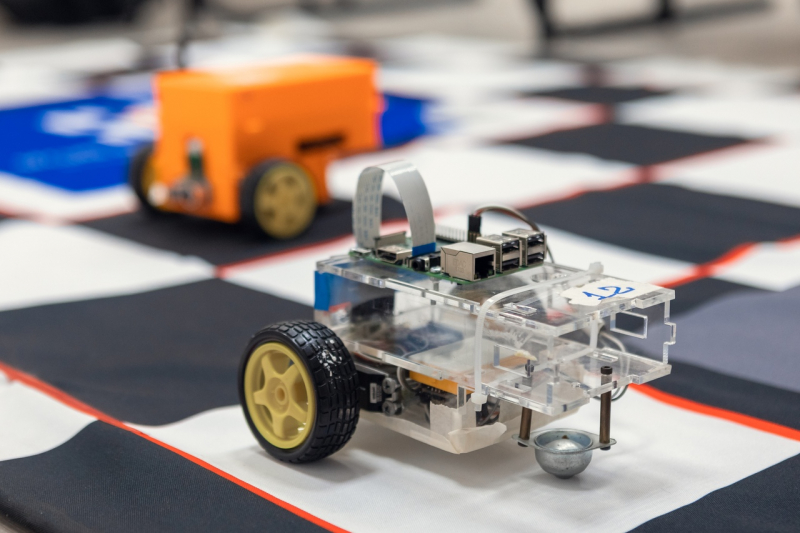
“For this purpose, the robots have inbuilt communication units, which allow them to exchange information and thus choose who will come first in case their trajectories intersect. If there are four cars that need to enter the same tile from four different sides – which is almost impossible – they’d have to determine their order at random, after taking into consideration the optimality criteria.”
The mockup is now used for training students of the Master’s program in Functional Safety of Pilotless Vehicles. Students use it to practice their skills in the fields of machine vision and pilotless systems design. The mockup is now also part of a new and more complex R&D project application, the results of which would later be applied in smart city infrastructure design.
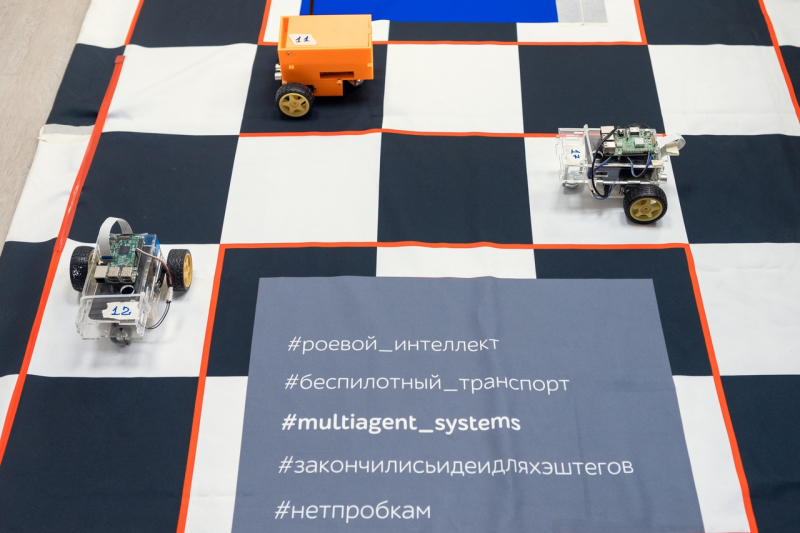
“This project has now entered ITMO’s competition of practice-oriented R&D projects. It will differ from the existing one by the introduction of static elements in addition to the dynamic ones – the so-called smart poles, which will also have inbuilt communication units. In terms of actual smart cities, it will be like this – each road intersection will have an infrastructure facility fitted to exchange data with driverless cars. They will inform the cars that the intersection is blocked by an accident or a traffic jam, and it’s better to avoid it by taking another route. This model can be scaled into a network covering the entire city. This new mockup will not only provide a testing facility for smart city management algorithms, but will also allow us to evaluate various data transfer protocols, and analyze the consequences of any possible network attacks,” concludes Sergey.
